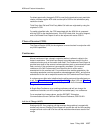
ASAI and Feature Interactions
12-24 Issue 7 May 1998
from the same vector. They must be specified back-to-back, without intermediate
steps (wait, announcement, goto, or stop). If the adjunct routing commands are
not specified back-to-back, G3V2 routing functionality applies (that is, previously
outstanding route requests are cancelled when an adjunct routing vector step is
executed). This capability increases the redundancy options available with ASAI.
Previously, adjunct routing applications that wanted to have a backup link had to
test whether or not the primary link was down and then execute the adjunct
routing command for the backup link with a vector. With this enhancement,
multiple adjuncts can route the call without waiting for the first route attempt to fail.
In addition, the application can use this feature to distribute the incoming call load
evenly across adjuncts, based on the adjunct’s CPU load.
Advice of Charge
Starting with R5: the call vectoring commands, route-to-digits, route to number,
and adjunct route can result in a redirection of an incoming call to a trunk that
provides charge advice. As a result, the charging number will reflect the current
value of the CDR calling number. Specifically, if any Charging Event Report is
generated after the call is redirected from a vector to an Advice of Charge (AOC)
trunk, the charging number will indicate the local party extension, or, in the case of
a redirected incoming trunk, the calling party number associated (if available) with
the incoming call.
Call Prompting
Up to 16 digits collected from the last collect digit vector command are passed to
the adjunct in the Call Offered to Domain Event Report (if they have been
collected before the call enters an Active Notification VDN) and the Route ASAI
capabilities.
Starting in R6.3, collected digits can be passed with the call to another ECS, if the
call is routed over an ISDN trunk which uses either supplementary service B
(QSIG), or shared UUI.
Lookahead Interflow (LAI)
This feature is activated by encountering a route to vector command, with the
route to destination being an off-ECS number, and having the ISDN-PRI,
Vectoring (Basic), and Lookahead Interflow options enabled on the Customer
Options form.
For the originating ECS, the interactions are the same as for any call being routed
to an off-ECS destination by the route to vector command.
For the receiving ECS, the lookahead interflow Information Element in the ISDN
message is included in all subsequent Call Offered to Domain Event Reports and
Route ASAI requests for the call, when the information exists, and when the call is


















